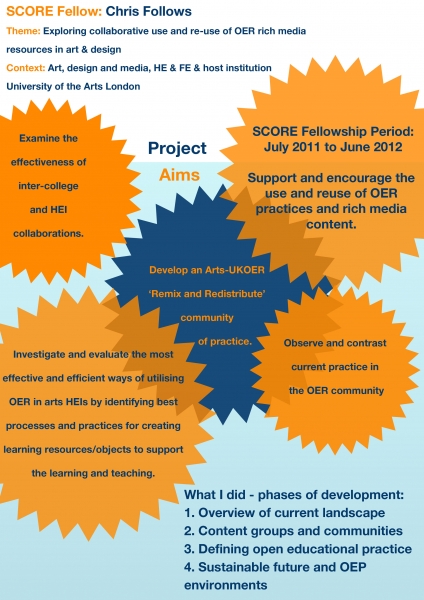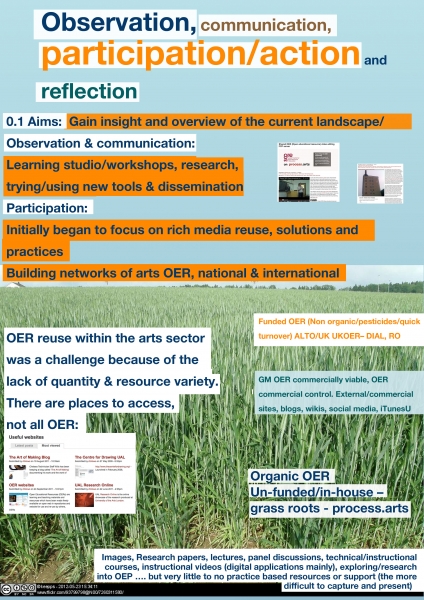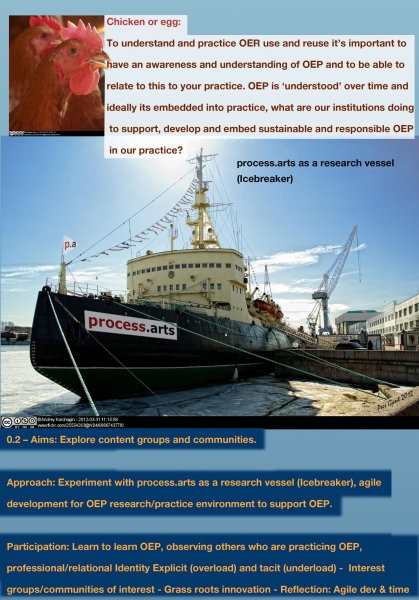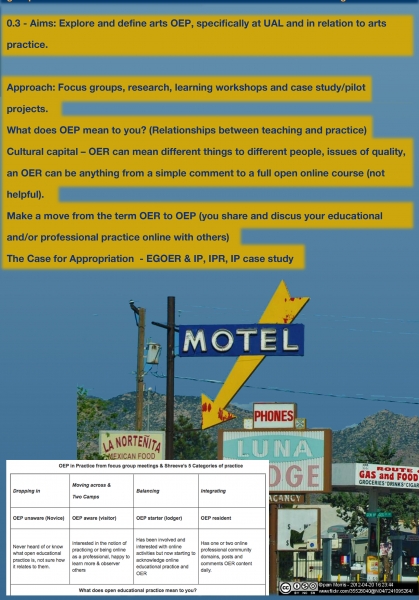SCORE presentation notes 31/05/12
Theme: Exploring collaborative use and re-use of OER rich media resources in art & design
|
SCORE Fellow: Chris Follows Context: Art, design and media, HE & FE, University of the Arts London host institution Project Aims Support and encourage the use and reuse of OER practices and rich media content. Investigate and evaluate the most effective and efficient ways of utilising OER in arts HEIs by identifying best processes and practices for creating learning resources/objects to support the learning and teaching. Observe and contrast current practice in the OER community. Examine the effectiveness of inter-college and HEI collaborations. Develop an Arts-UKOER ‘Remix and Redistribute’ community of practice. What I did: I went through three phases of development: Overview of current landscape Content groups and communities Defining open educational practice Sustainable future and OEP environments Observation, communication, participation/action and reflection 0.1 Aims: Gain insight and overview of the current landscape/ Approach: Project set up and to gain institutional, local and national overview Observation & communication: Participation: I looked at building a network of arts OER, national and international (conference 1) The process of encouraging/practicing OER reuse within the arts sector was a challenge because of the lack of quantity and resource variety. There are places to access, not all OER: UAL institutional: Funded OER (Non organic/pesticides/quick turnover) GM OER commercially viable, OER commercial control Organic OER General institutional: Images, Research papers, lectures, panel discussions, technical/instructional courses, instructional videos (digital applications mainly), exploring/research into OEP (Kingston & ADM subject centre) …. but very little to no practice based resources or support (the more difficult to capture and present) Reflection: Chicken or egg: To understand and practice OER use and reuse it’s important to have an awareness and understanding of OEP and to be able to relate to this to your practice. OEP is ‘understood’ over time and ideally its embedded into practice, what are our institutions doing to support, develop and embed sustainable and responsible OEP in our practice? |
|||||||||||||
|
0.2 – Aims: Explore content groups and communities. Participation: Learn to learn OEP, observing others who are practicing OEP, professional/relational Identity Explicit (overload) and tacit (underload) Interest groups/communities of interest Grass roots innovation Reflection: Agile development and time
0.3 - Aims: Explore and define arts OEP, specifically at UAL and in relation to arts practice. What does OEP mean to you? (Relationships between teaching and practice) Cultural capital – OER can mean different things to different people, issues of quality, an OER can be anything from a simple comment to a full open online course (not helpful). Make a move from the term OER to OEP (you share and discus your educational and/or professional practice online with others) The Case for Appropriation EGOER & IP, IPR, IP case study OEP in Practice from focus group meetings & Shreeve’s 5 Categories of practice - http://process.arts.ac.uk/content/practice-teaching-and-open-educational-practice
0.4 - Aims: create a sustainable environment for supporting the experimentation and development of OEP? Approach: Explore sustainable OEP environments. Sustainable platforms Drupal V’s Edshare Edu-social Process.arts, a grass roots web2.0 open educational environment for sharing day-to-day arts practice and research of staff and students, currently provides a new ‘open learning’ space to the University of the Arts London (UAL) that straddles the institution/educational (formal learning) environment and the social (informal learning) environment. It creates an ‘experimental’ space for open educational practitioners to develop and define a new language for open edu-social practice without conforming or being influenced by pre-existing academic structures and processes. The transition of process.arts into an official UAL service will test this model and raise questions as to how institutions successfully support and develop autonomous and independent grassroots innovation without homogenising innovation. What next The OEP Unit at UAL |
|||||||||||||
| Attachment | Size |
|---|---|
| infographic_score-04.jpg | 960.65 KB |
| infographic_score-03.jpg | 1.04 MB |
| infographic_score-02.jpg | 1.42 MB |
| infographic_score-01.jpg | 869.53 KB |
| chris_follows-poland.jpg | 52.08 KB |

To the extent possible under law, cfollows has waived all copyright and related or neighboring rights to this Work, SCORE presentation notes 31/05/12.







Comments
Email below from Witthaus, Gabi R. [grw8@leicester.ac.uk] Thank you Gabi, it's brilliant blog post :)
Thank you Jackie, it would be good to meet up, will you be at the HEA conference ? This is the latest thoughts regarding the process.arts/VLE transition - http://process.arts.ac.uk/content/alt-c-2012-mainstreaming-grass-roots-innovation-open-educational-practice-benefits-and-chall
Really enjoyed the presentation today Chris. Would love to talk more about use of Drupal and how process.arts will be brought into the VLE.